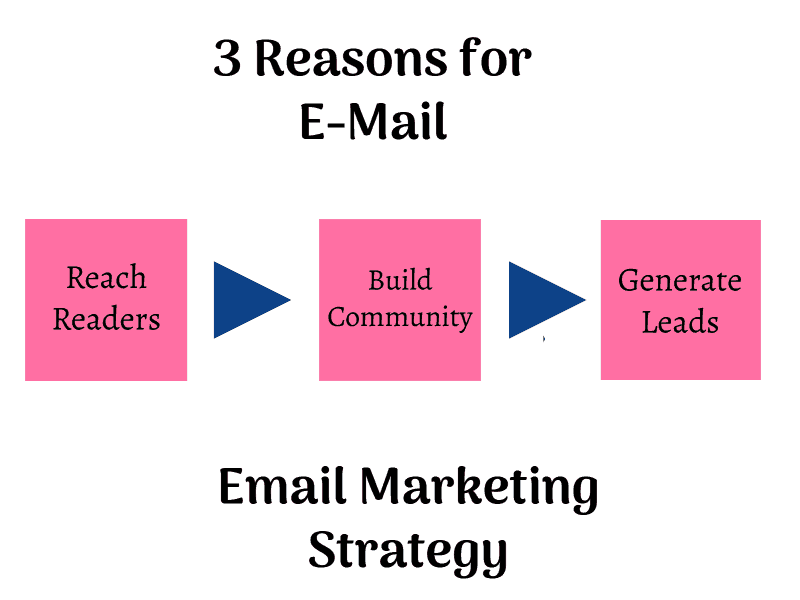Welcome to day 5 and the last day of the ‘Plan your Blog’ series. We’ve already covered why you need a bullet journal for your blog, how to set up your blog for success, how to find your target audience and how to create a content marketing strategy.
In today’s post, I’ll cover the one thing that most bloggers neglect: Email marketing and why you need to create a plan for it.
This post contains links to the Amazon affiliate program. As an Amazon Associate I earn from qualifying purchases. You can read my complete Disclosure policy here.

This post contains Affiliate links. Read my complete disclosure policy here.
Why Email Marketing is Important
Three words: No algorithm changes.
The main issue with the way most of us market our content is that we tend to rely heavily on one of the popular social media channels such as Facebook, Twitter, Instagram or Pinterest.
But the truth is, none of those channels are consistently reliable due to frequent algorithmic changes. While I personally love Pinterest for the traffic it sends me, Facebook for my thriving community and Instagram for its high-conversion rate, I know the facts.
Any of those channels can change things in the blink of an eye and there’s nothing we can do about it.
*Did you know Google Plus is shutting down in 2019? That’s right. And think about how many communities/pages/ profiles will disappear with it.
Email on the other hand is not bound by an algorithm or limited by age and location.
Everyone uses email, whether they’re 18 or 80.
That’s why it’s important.
But email has different purposes for different groups of bloggers and that’s what we’ll cover in today’s post.

Personally, I use all three versions of this strategy, but the good news is you don’t have to! You can pick and choose the strategy that will work for your specific purpose.
Next, remember that there are two types of e-mails you can send to your readers.
The first type is the RSS feed, which is an automated mailer that notifies your readers that you’ve published a new post. This is what we use in Strategy #1
The second is a newsletter that goes out to subscribers who have a specific need that you can address. This is what we use in Strategies 2 and 3.

We will go into further details in the points below.
1. Email marketing: Reach your readers

A blog is present on the internet for a variety of reasons. But the universal truth is we’d all like readers of our work. I know a lot of people say they write without worrying about readers, but if that were really the case, they’d not be writing it on a public blog.
*I do understand the ones who say they don’t write for numbers, which is a totally different subject, by the way. 😉
Almost every blog on WordPress, both the free and the paid versions, will have a Jetpack subscription box. In fact, up until last week, this blog had it too.
That subscription box is your RSS feed. Every time you publish a new post, a mail automatically goes out to your readers, notifying them of the update.
But I’d heard so much about how Jetpack hogs resources and slows down the website that I decided to un-install it last week. Really! It was hard, to be honest, because I’d had it forever.
Then, I set up an RSS feed with MailChimp, who used to be my e-mail provider for 2 years before I switched over to Mailerlite.
Tutorial: How to set up an RSS feed with MailChimp
Why an RSS feed:
i) It cuts through the social media clutter and heads straight to the inbox
ii) Email traffic ranks consistently better than social media traffic
iii) You can customise it with your logo/ a message/ filter it by segment to specific users
iv) Ranking on Google can take time, but an email list is something you can build from Day 1!
Where to display the sign up form:
You can embed it at the end of your blog posts, like I have in this one.
You can also include it in the middle of a blog post, at the end of a relevant section, as I have done in today’s post.
Other places to include your sign up form are your blog’s sidebar, your ‘About me’ page and your ‘Work with me’ page.
Start off with Mailerlite, if you’re building your list. The reason I recommend Mailerlite is because it is free for up to 1000 subscribers. It’s perfect to get started, for new bloggers and has the most robust set of features on the free plan.
Find this challenging? Sign up for a one-on-one session where I will teach you how to use Mailerlite for email marketing
2. Email Marketing to Build a Community

Before you begin sending out emails using this strategy, I urge you to read my post on 8 Things to remember before you launch your newsletter.
How to launch your Newsletter and 8 things to remember before you do!
Building a community with an e-mail list is sheer genius. And the best part? You are active and engaging with your audience on the list, because there are no other shiny distractions like notifications on social media. Win-win!
For me, the most active community is on Instagram. Since my audience is present on that platform, it’s easy for me to reach them there and through my e-mail list. It builds conversations around a topic that many other people are worried about.
You can do the same thing! Let’s assume you have a blog/website dedicated to serving your local area in some manner. Or let’s say you have a small business and you’re hoping to reach them through an Instagram page. Maybe you have a fitness program that will help busy mothers.
An e-mail list will ensure that interested buyers or volunteers are notified directly instead of relying on social media updates.
Perfect, right?
How to get subscribers:
i) Create a dedicated landing page either on your blog itself or on the email client’s page.
ii) Talk about the benefits of joining your list.
iii) Share testimonials from existing community members to explain why this would be a good fit for them.
3. Email Marketing for Lead Generation

Remember how I mentioned ‘marketing funnel’ in yesterday’s post on content marketing? The same principle applies when you think of lead generation using emails.
Lead generation is a very simple but effective concept. If you own an online or brick-and-mortar store or if you’re a solo entrepreneur who wants to sell courses or a set of services or if you’re a trainer who conducts workshops, you need lead generation.
As explained in the previous two points, your e-mail list is where you will get your loyal followers and subscribers.
Want tips on getting your first 100 subscribers? Check out Meera’s book linked below. It’s perfect for the purpose.
Lead generation is another way of saying ‘Market yourself to your email list’.
But there’s a nice way of doing it. 🙂
Remember that the first rule of lead generation is that you shouldn’t try to sell things to people the minute they land on your list. You have to generate interest, create a relationship, build a connection with them
Meera Kothand explains this as ‘nurturing your email list.’
How do you do it?
a) Be helpful
When someone mails you a question related to your niche, help them genuinely, without promoting yourself. If it is something that will take less than 2 minutes to solve, do it then and there.
If you feel that this will require greater detail, set up a discovery/consulting call with them. Don’t be shy about charging for this, because most often, people will pay that nominal fee if it means direct and one-on-one advice.
b) Respond to your emails
An email marketing strategy will work only if you actually take the time to reply to emails. Whether it’s someone sending you a mail to thank you for the post they read or someone expressing gratitude for a course you sold, take time to reply to your emails.
People love it when you pay special attention to them and your subscribers are no different. Make the time.
c) Be patient
Lead generation takes time. Remember, for people to spend money on anything that you offer or recommend, there are two crucial factors at work:
- Trust in the product
- Trust in you, as a person.
Trust doesn’t happen overnight. It takes a while before people will open their wallets readily for anything you offer.
But a good email list will definitely help towards building that trust.
Missed reading the other posts in this series? Here they are:
Day 1’s post : Why you need a Bullet Journal for your Blog
Day 2’s Post: How to set up your Blog and Optimize it for Success
Day 3’s post: 10 Ways to find your Target Audience for the Blog
Day 4’s post: How to create a Content Marketing Plan for the Blog


Shailaja V
Hi, I’m Shailaja, a blogger who’s been writing since 2007. My interests include books of all kinds, digital minimalism, veganism, health, nutrition, fitness and staying open to learning all the time. Welcome! Click here if you’d like an email when I publish new posts
Enjoyed this article? I welcome you to let me know your thoughts on this post via email here: shailaja@shailajav.com

As you know, I am going to launch my newsletter soon. This was something I was wanting to do from a long time, but waited on it, to figure out the value proposition. At this point, all I am trying to do is connect with the readers, and provide some value to them, instead of making it all about me, and my post updates.
Because in this time-pressed world, I personally click on the emails that have something for me as well. That being said, I know there will be some trial & error before I get it right. It scares me a bit, but also excites me. So fingers crossed.
Motivated for email marketing in blogging. Thank you so much for sharing your thoughts.